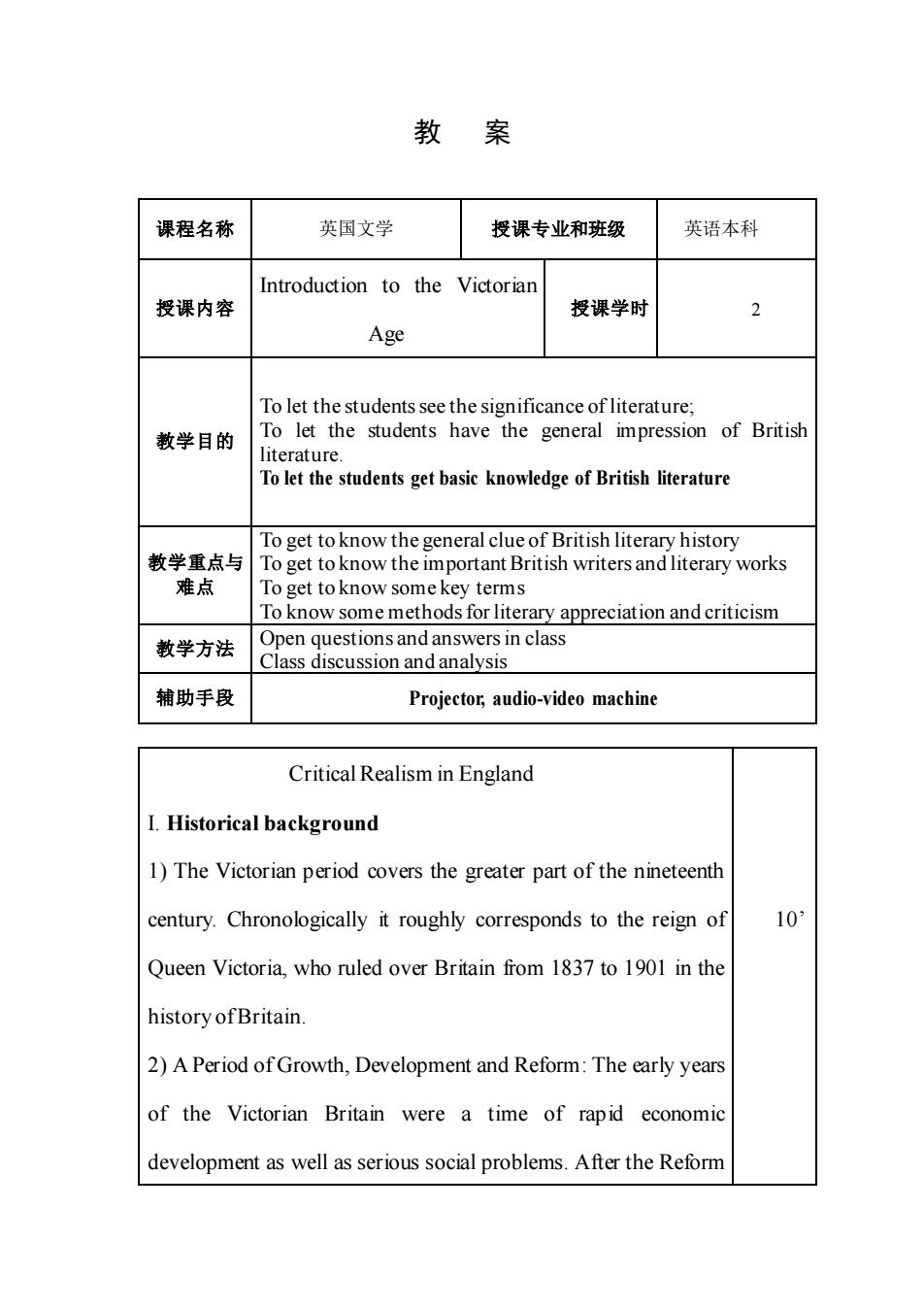
教案 课程名称 英国文学 授课专业和班级 英语本科 Introduction to the Victorian 授课内容 授课学时 2 Age To let the students see the significance of literature. 教学目的 To let the students have the general impression of British literature. To let the students get basic knowledge of British literature To get to know the general clue of British literary history 教学重点与 To get to know the important British writers and literary works 难点 To get to know some key terms To know some methods for literary appreciation and criticism 教学方法 辅助手段 Projector,audio-video machine Critical Realism in England I.Historical background 1)The Victorian period covers the greater part of the nineteenth century.Chronologically it roughly corresponds to the reign of 10 Queen Victoria,who ruled over Britain from 1837 to 1901 in the history ofBritain 2)A Period of Growth,Development and Reform:The early years of the Victorian Britain were a time of rapid economic development as well as serious social problems.After the Reform
教 案 课程名称 英国文学 授课专业和班级 英语本科 授课内容 Introduction to the Victorian Age 授课学时 2 教学目的 To let the students see the significance of literature; To let the students have the general impression of British literature. To let the students get basic knowledge of British literature 教学重点与 难点 To get to know the general clue of British literary history To get to know the important British writers and literary works To get to know some key terms To know some methods for literary appreciation and criticism 教学方法 Open questions and answers in class Class discussion and analysis 辅助手段 Projector, audio-video machine Critical Realism in England I. Historical background 1) The Victorian period covers the greater part of the nineteenth century. Chronologically it roughly corresponds to the reign of Queen Victoria, who ruled over Britain from 1837 to 1901 in the history of Britain. 2) A Period of Growth, Development and Reform: The early years of the Victorian Britain were a time of rapid economic development as well as serious social problems. After the Reform 10’
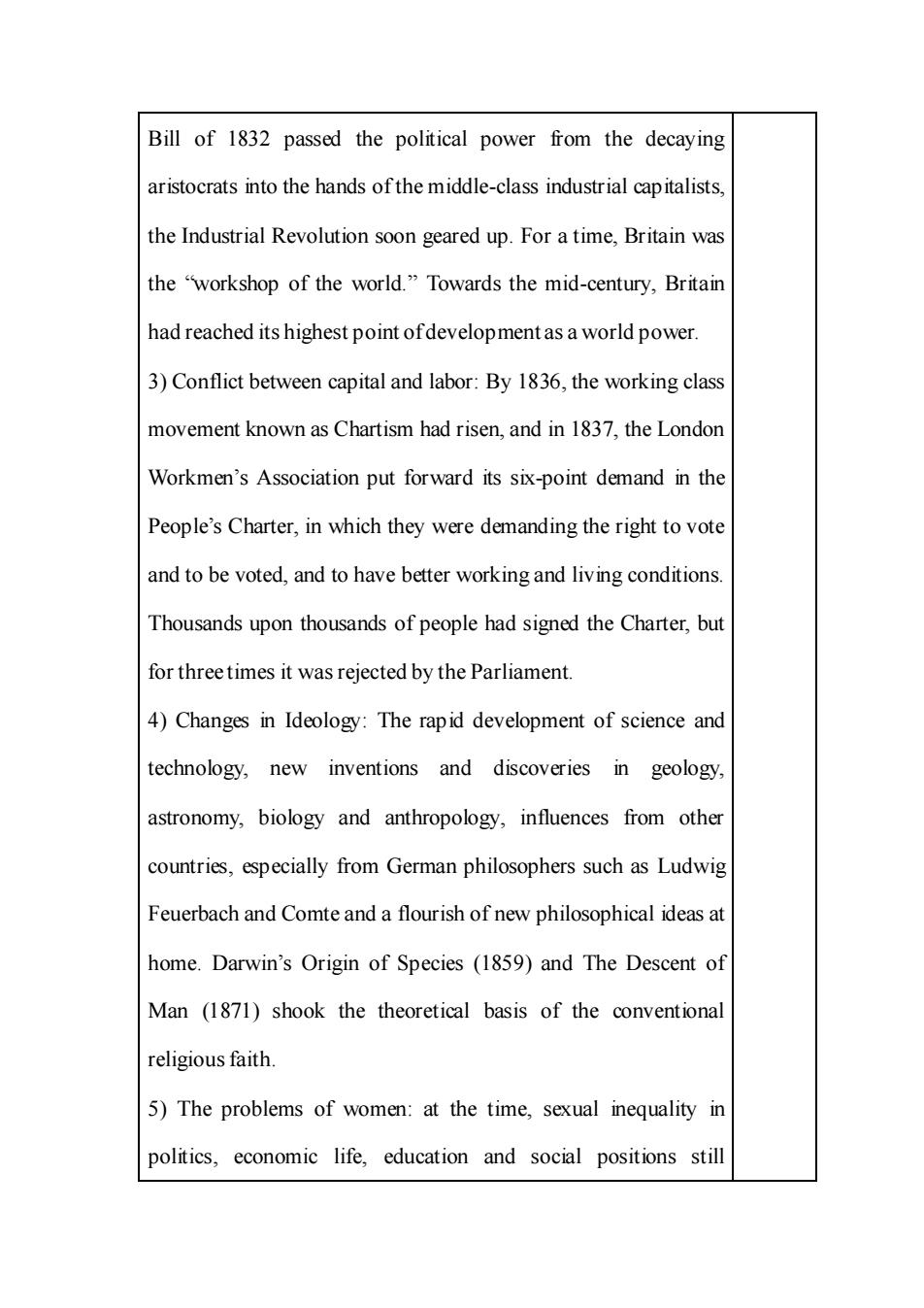
Bill of 1832 passed the political power from the decaying aristocrats into the hands of the middle-class industrial capitalists. the Industrial Revolution soon geared up.For a time,Britain was the workshop of the world."Towards the mid-century,Britain had reached its highest point ofdevelopment as a world power. 3)Conflict between capital and labor:By 1836,the working class movement known as Chartism had risen,and in 1837,the London Workmen's Association put forward its six-point demand in the People's Charter,in which they were demanding the right to vote and to be voted,and to have better working and living conditions. Thousands upon thousands of people had signed the Charter,but for threetimes it was rejected by the Parliament. 4)Changes in Ideology:The rapid development of science and technology,new inventions and discoveries in geology. astronomy,biology and anthropology,influences from other countries,especially from German philosophers such as Ludwig Feuerbach and Comte and a flourish of new philosophical ideas at home.Darwin's Origin of Species (1859)and The Descent of Man (1871)shook the theoretical basis of the conventional religious faith 5)The problems of women:at the time,sexual inequality in politics,economic life,education and social positions still
Bill of 1832 passed the political power from the decaying aristocrats into the hands of the middle-class industrial capitalists, the Industrial Revolution soon geared up. For a time, Britain was the “workshop of the world.” Towards the mid-century, Britain had reached its highest point of development as a world power. 3) Conflict between capital and labor: By 1836, the working class movement known as Chartism had risen, and in 1837, the London Workmen’s Association put forward its six-point demand in the People’s Charter, in which they were demanding the right to vote and to be voted, and to have better working and living conditions. Thousands upon thousands of people had signed the Charter, but for three times it was rejected by the Parliament. 4) Changes in Ideology: The rapid development of science and technology, new inventions and discoveries in geology, astronomy, biology and anthropology, influences from other countries, especially from German philosophers such as Ludwig Feuerbach and Comte and a flourish of new philosophical ideas at home. Darwin’s Origin of Species (1859) and The Descent of Man (1871) shook the theoretical basis of the conventional religious faith. 5) The problems of women: at the time, sexual inequality in politics, economic life, education and social positions still
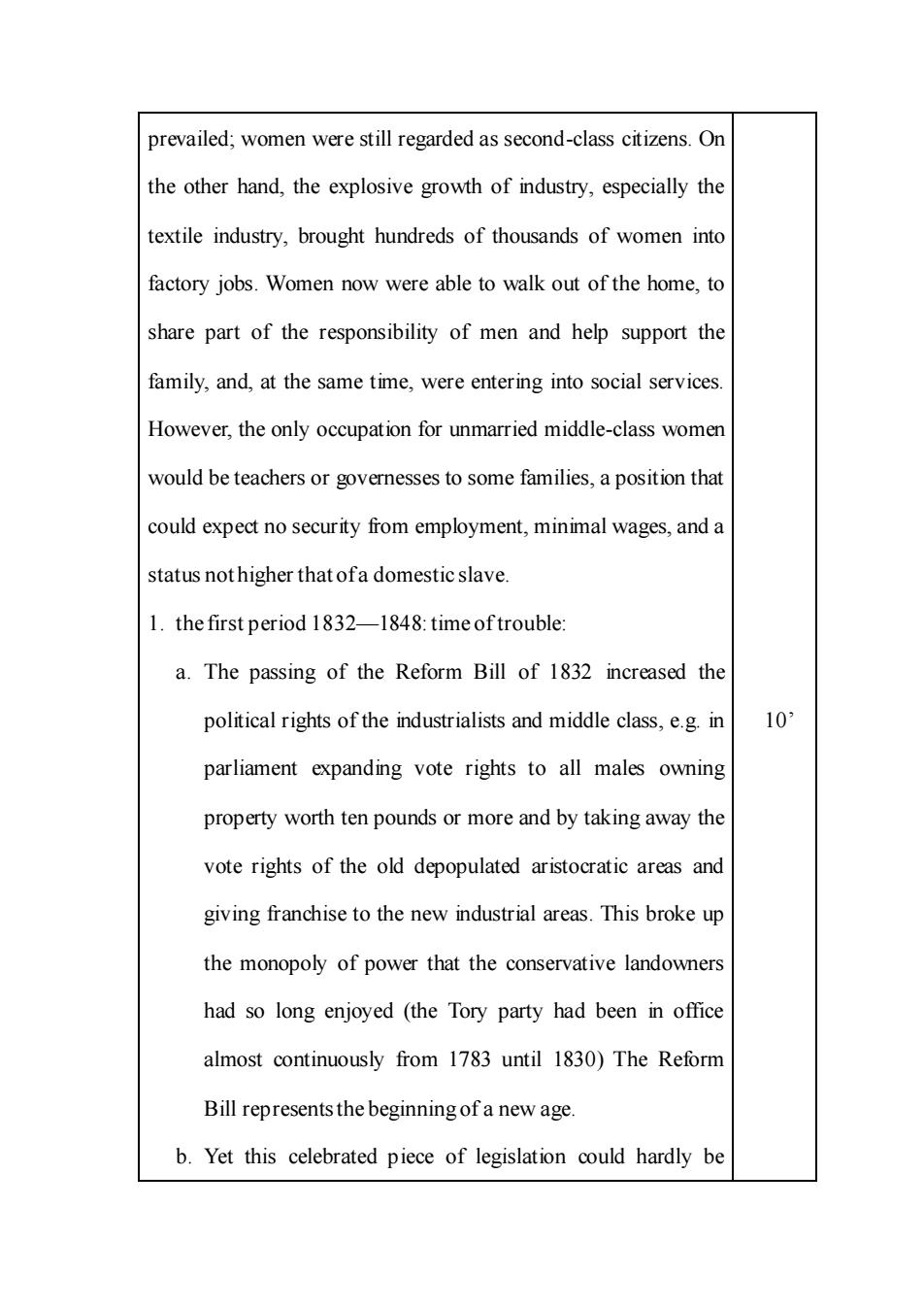
prevailed;women were still regarded as second-class citizens.On the other hand,the explosive growth of industry,especially the textile industry,brought hundreds of thousands of women into factory jobs.Women now were able to walk out of the home,to share part of the responsibility of men and help support the family,and,at the same time,were entering into social services However,the only occupation for unmarried middle-class women would be teachers or governesses to some families,a position that could expect no security from employment,minimal wages,and a status nothigher that ofa domestic slave. 1.the first period 1832-1848:time of trouble: a.The passing of the Reform Bill of 1832 increased the political rights of the industrialists and middle class,e.g.in 10 parliament expanding vote rights to all males owning property worth ten pounds or more and by taking away the vote rights of the old depopulated aristocratic areas and giving franchise to the new industrial areas.This broke up the monopoly of power that the conservative landowners had so long enjoyed(the Tory party had been in office almost continuously from 1783 until 1830)The Reform Bill represents the beginning of a new age. b.Yet this celebrated piece of legislation could hardly be
prevailed; women were still regarded as second-class citizens. On the other hand, the explosive growth of industry, especially the textile industry, brought hundreds of thousands of women into factory jobs. Women now were able to walk out of the home, to share part of the responsibility of men and help support the family, and, at the same time, were entering into social services. However, the only occupation for unmarried middle-class women would be teachers or governesses to some families, a position that could expect no security from employment, minimal wages, and a status not higher that of a domestic slave. 1. the first period 1832—1848: time of trouble: a. The passing of the Reform Bill of 1832 increased the political rights of the industrialists and middle class, e.g. in parliament expanding vote rights to all males owning property worth ten pounds or more and by taking away the vote rights of the old depopulated aristocratic areas and giving franchise to the new industrial areas. This broke up the monopoly of power that the conservative landowners had so long enjoyed (the Tory party had been in office almost continuously from 1783 until 1830) The Reform Bill represents the beginning of a new age. b. Yet this celebrated piece of legislation could hardly be 10’
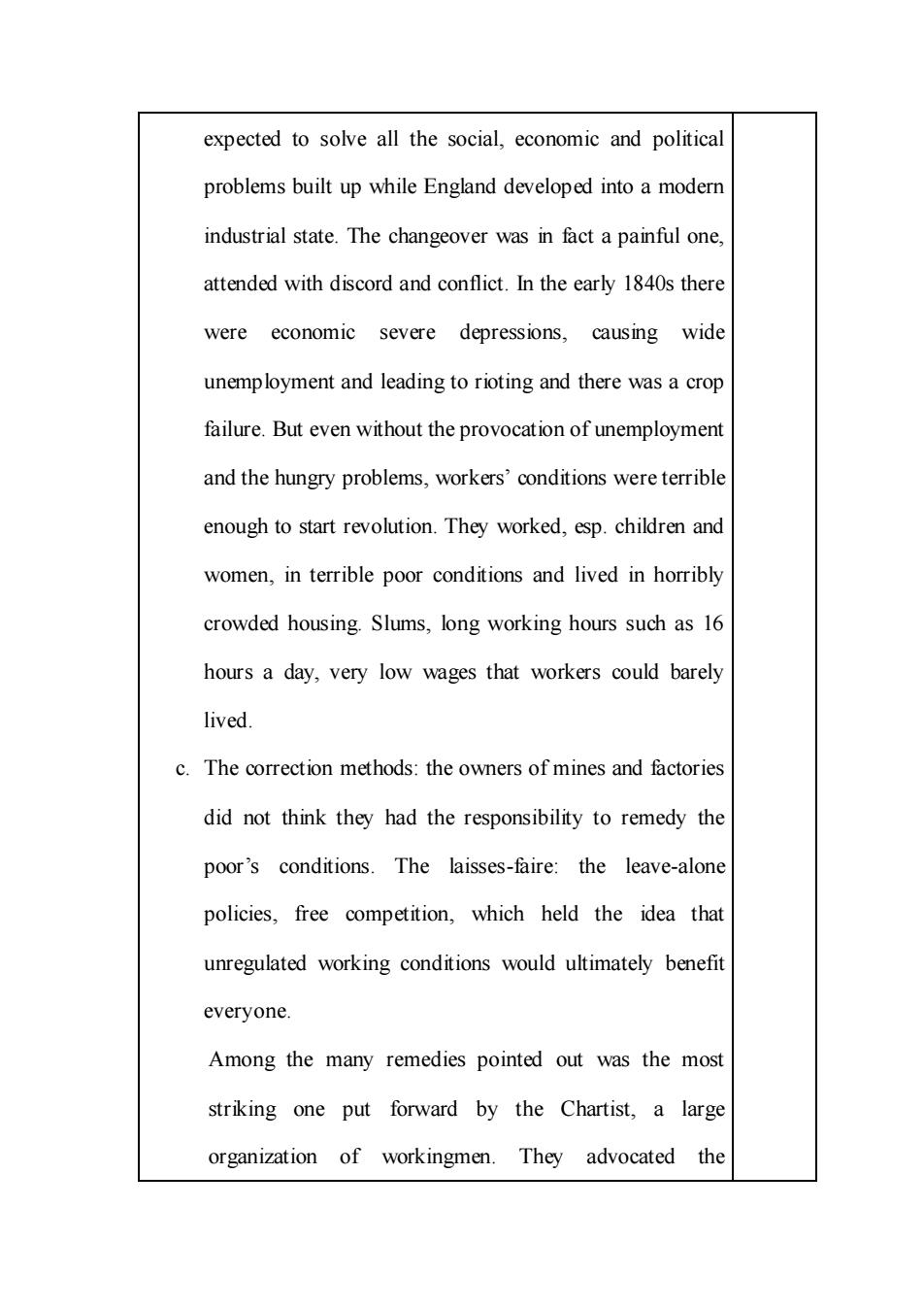
expected to solve all the social,economic and politica problems built up while England developed into a modern industrial state.The changeover was in fact a painful one attended with discord and conflict.In the early 1840s there were economic severe depressions,causing wide unemployment and leading to rioting and there was a crop failure.But even without the provocation of unemployment and the hungry problems,workers'conditions were terrible enough to start revolution.They worked,esp.children and women,in terrible poor conditions and lived in horribly crowded housing Slums,long working hours such as 16 hours a day,very low wages that workers could barely lived. c.The correction methods:the owners of mines and factories did not think they had the responsibility to remedy the poor's conditions.The laisses-faire:the leave-alone policies,free competition,which held the idea that unregulated working conditions would ultimately benefit everyone. Among the many remedies pointed out was the most striking one put forward by the Chartist,a large organization of workingmen.They advocated the
expected to solve all the social, economic and political problems built up while England developed into a modern industrial state. The changeover was in fact a painful one, attended with discord and conflict. In the early 1840s there were economic severe depressions, causing wide unemployment and leading to rioting and there was a crop failure. But even without the provocation of unemployment and the hungry problems, workers’ conditions were terrible enough to start revolution. They worked, esp. children and women, in terrible poor conditions and lived in horribly crowded housing. Slums, long working hours such as 16 hours a day, very low wages that workers could barely lived. c. The correction methods: the owners of mines and factories did not think they had the responsibility to remedy the poor’s conditions. The laisses-faire: the leave-alone policies, free competition, which held the idea that unregulated working conditions would ultimately benefit everyone. Among the many remedies pointed out was the most striking one put forward by the Chartist, a large organization of workingmen. They advocated the
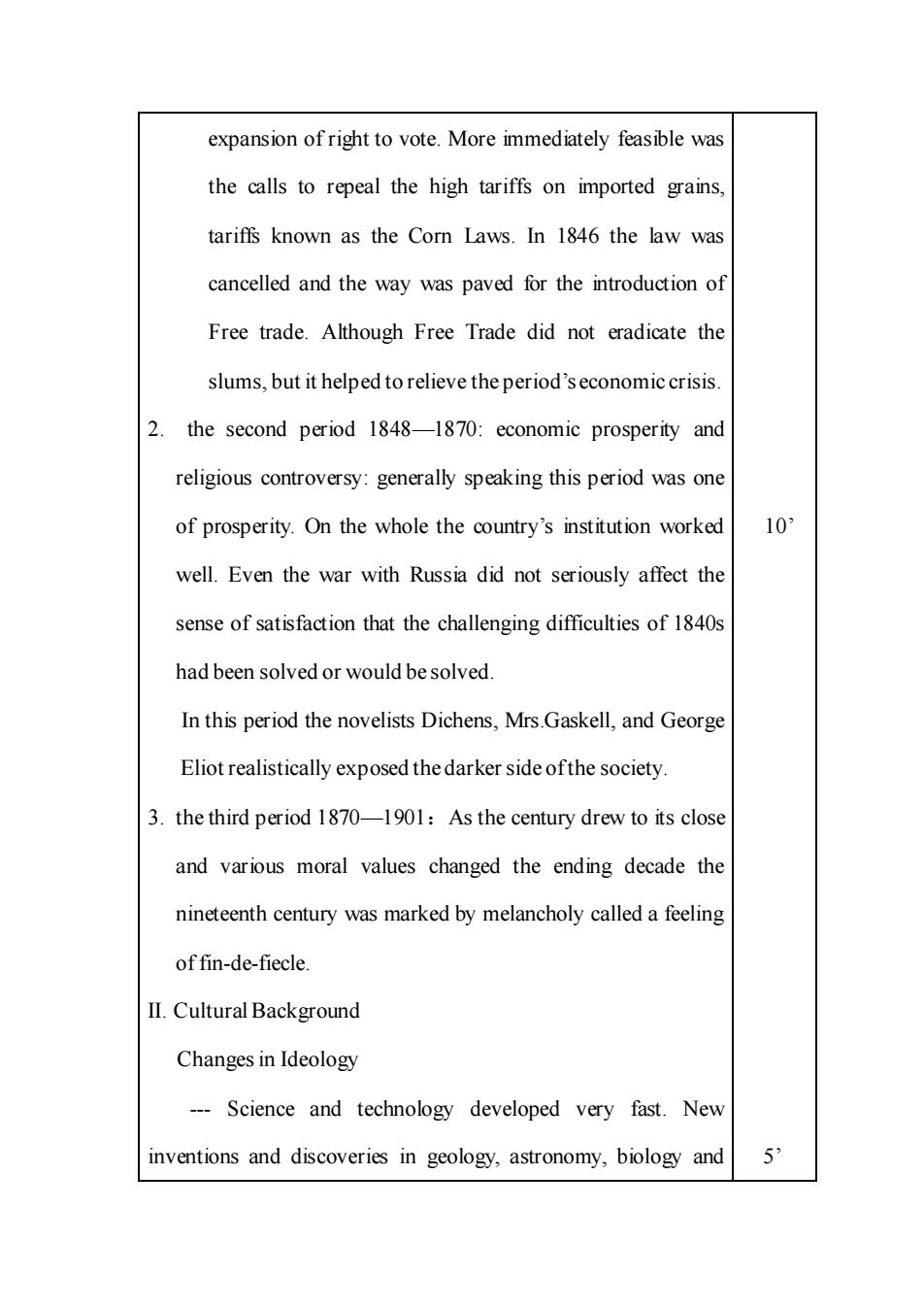
expansion of right to vote.More immediately feasible was the calls to repeal the high tariffs on imported grains, tariffs known as the Corn Laws.In 1846 the law was cancelled and the way was paved for the introduction of Free trade.Although Free Trade did not eradicate the slums,but it helped to relieve the period'seconomic crisis. 2. the second period 1848-1870:economic prosperity and religious controversy:generally speaking this period was one of prosperity.On the whole the country's institution worked 10 well.Even the war with Russia did not seriously affect the sense of satisfaction that the challenging difficulties of 1840s had been solved or would be solved. In this period the novelists Dichens,Mrs.Gaskell,and George Eliot realistically exposed the darker side ofthe society. 3.the third period 1870-1901:As the century drew to its close and various moral values changed the ending decade the nineteenth century was marked by melancholy called a feeling of fin-de-fiecle. II.Cultural Background Changes in Ideology -Science and technology developed very fast.New inventions and discoveries in geology,astronomy,biology and 53
expansion of right to vote. More immediately feasible was the calls to repeal the high tariffs on imported grains, tariffs known as the Corn Laws. In 1846 the law was cancelled and the way was paved for the introduction of Free trade. Although Free Trade did not eradicate the slums, but it helped to relieve the period’s economic crisis. 2. the second period 1848—1870: economic prosperity and religious controversy: generally speaking this period was one of prosperity. On the whole the country’s institution worked well. Even the war with Russia did not seriously affect the sense of satisfaction that the challenging difficulties of 1840s had been solved or would be solved. In this period the novelists Dichens, Mrs.Gaskell, and George Eliot realistically exposed the darker side of the society. 3. the third period 1870—1901:As the century drew to its close and various moral values changed the ending decade the nineteenth century was marked by melancholy called a feeling of fin-de-fiecle. II. Cultural Background Changes in Ideology - Science and technology developed very fast. New inventions and discoveries in geology, astronomy, biology and 10’ 5’

anthropology drastically changed people's life -German philosophers such as Ludwig Feuerbach and Comte exerted great influences over British ideological field. -Darwin's Origin of Species (1859)and The Descent of Man (1871)shook the theoretical basis of the conventional religious faith. The Problem of Women -In 1837 when Queen Victoria came to the throne,married women had no property rights,not even in the proceeds of their ⊙ own earnings.They had no rights to custody of their own children and were excluded from universities and professions. -In this period,sexual inequality in politics,economic life. education and social positions still prevailed;women were still regarded as second-class citizens. -The explosive growth of industry,especially the textile industry,brought hundreds of thousands of women into factory jobs. -In factories,women were employed as cheap labor and were forced to do very heavy and hard jobs for about half the usual pay.The unbearable working conditions and unemployment drove thousands of women into prostitution. -Factory work presented an increasing challenge to the
anthropology drastically changed people’s life. - German philosophers such as Ludwig Feuerbach and Comte exerted great influences over British ideological field. - Darwin’s Origin of Species (1859) and The Descent of Man (1871) shook the theoretical basis of the conventional religious faith. The Problem of Women - In 1837 when Queen Victoria came to the throne, married women had no property rights, not even in the proceeds of their own earnings. They had no rights to custody of their own children and were excluded from universities and professions. - In this period, sexual inequality in politics, economic life, education and social positions still prevailed; women were still regarded as second-class citizens. - The explosive growth of industry, especially the textile industry, brought hundreds of thousands of women into factory jobs. - In factories, women were employed as cheap labor and were forced to do very heavy and hard jobs for about half the usual pay. The unbearable working conditions and unemployment drove thousands of women into prostitution. - Factory work presented an increasing challenge to the 10’

conventional ideas of women and opened up new and wide spheres for women. -Women now were able to walk out of the home,to share part of the responsibility of men and help support the family,and,at the same time,were entering into social services. -A feminist movement started,fighting for women's equality and freedom,and for their educational and employment opportunities. III.Victorian Literature:Mainly three kinds: the Chartist literature English Critical Realism 5 Victorianpoetry IV.Chartist Literature 1.Introduction Chartism was a national political movement,associated with working-class radicalism,with the avowed goal of forcing the British parliament to accept the"Six Points"of the People's 10 Charter:a vote for every man over 21,secret ballots,no property qualification for MPs,salaries for MPs,equal constituencies,and annual parliaments.All of these demands except the last would be met within a century.The People's Charter originated from the London Working Men's
conventional ideas of women and opened up new and wide spheres for women. - Women now were able to walk out of the home, to share part of the responsibility of men and help support the family, and, at the same time, were entering into social services. - A feminist movement started, fighting for women’s equality and freedom, and for their educational and employment opportunities. III. Victorian Literature: Mainly three kinds: the Chartist literature English Critical Realism Victorian poetry IV. Chartist Literature 1. Introduction Chartism was a national political movement, associated with working-class radicalism, with the avowed goal of forcing the British parliament to accept the “Six Points” of the People’s Charter: a vote for every man over 21, secret ballots, no property qualification for MPs, salaries for MPs, equal constituencies, and annual parliaments. All of these demands except the last would be met within a century. The People’s Charter originated from the London Working Men’s 5’ 10’
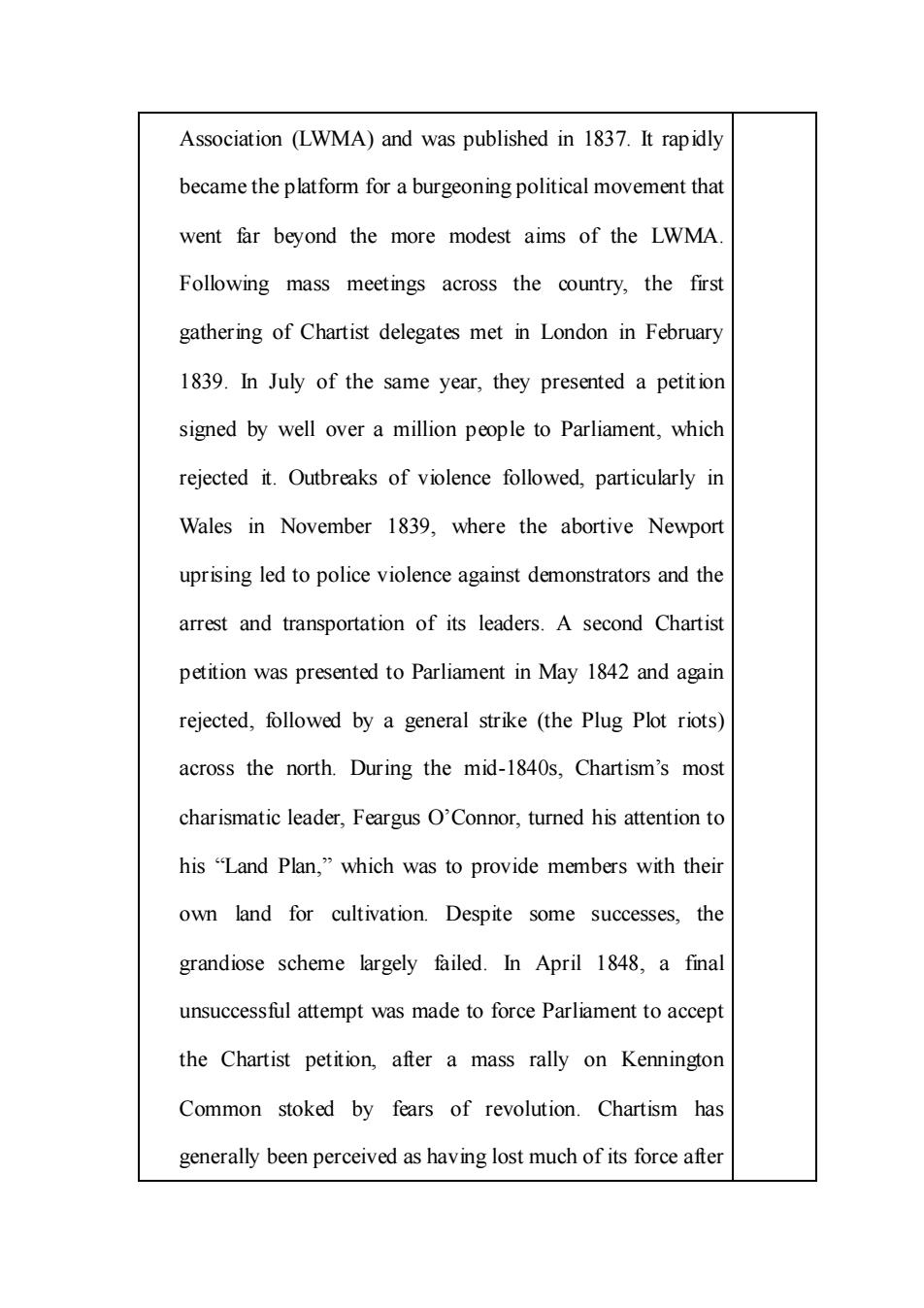
Association (LWMA)and was published in 1837.It rapidly became the platform for a burgeoning political movement that went far beyond the more modest aims of the LWMA Following mass meetings across the country,the firs gathering of Chartist delegates met in London in February 1839.In July of the same year,they presented a petition signed by well over a million people to Parliament,which rejected it.Outbreaks of violence followed,particularly in Wales in November 1839,where the abortive Newport uprising led to police violence against demonstrators and the arrest and transportation of its leaders.A second Chartist petition was presented to Parliament in May 1842 and again rejected,followed by a general strike (the Plug Plot riots) across the north.During the mid-1840s,Chartism's most charismatic leader,Feargus O'Connor,turned his attention to his "Land Plan,"which was to provide members with their own land for cultivation.Despite some successes,the grandiose scheme largely failed.In April 1848,a final unsuccessful attempt was made to force Parliament to accept the Chartist petition,after a mass rally on Kennington Common stoked by fears of revolution.Chartism has generally been perceived as having lost much of its force after
Association (LWMA) and was published in 1837. It rapidly became the platform for a burgeoning political movement that went far beyond the more modest aims of the LWMA. Following mass meetings across the country, the first gathering of Chartist delegates met in London in February 1839. In July of the same year, they presented a petition signed by well over a million people to Parliament, which rejected it. Outbreaks of violence followed, particularly in Wales in November 1839, where the abortive Newport uprising led to police violence against demonstrators and the arrest and transportation of its leaders. A second Chartist petition was presented to Parliament in May 1842 and again rejected, followed by a general strike (the Plug Plot riots) across the north. During the mid-1840s, Chartism’s most charismatic leader, Feargus O’Connor, turned his attention to his “Land Plan,” which was to provide members with their own land for cultivation. Despite some successes, the grandiose scheme largely failed. In April 1848, a final unsuccessful attempt was made to force Parliament to accept the Chartist petition, after a mass rally on Kennington Common stoked by fears of revolution. Chartism has generally been perceived as having lost much of its force after
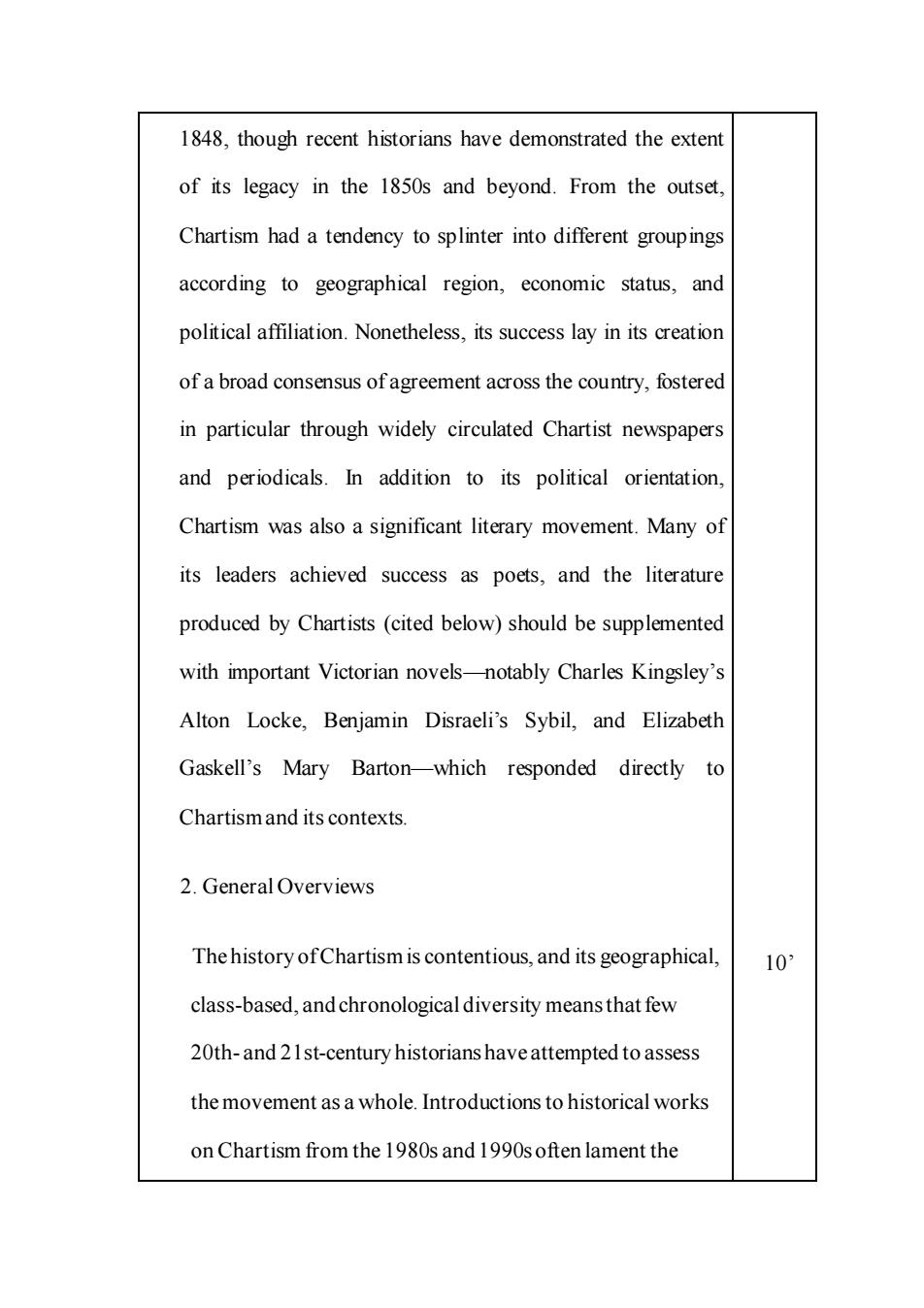
1848,though recent historians have demonstrated the extent of its legacy in the 1850s and beyond.From the outset, Chartism had a tendency to splinter into different groupings according to geographical region,economic status,and political affiliation.Nonetheless,its success lay in its creation of a broad consensus ofagreement across the country,fostered in particular through widely circulated Chartist newspapers and periodicals.In addition to its political orientation, Chartism was also a significant literary movement.Many of its leaders achieved success as poets,and the literature produced by Chartists (cited below)should be supplemented with important Victorian novels-notably Charles Kingsley's Alton Locke,Benjamin Disraeli's Sybil,and Elizabeth Gaskell's Mary Barton-which responded directly to Chartismand its contexts 2.GeneralOverviews The history ofChartism is contentious,and its geographical, 10 class-based,andchronological diversity meansthat few 20th-and 21st-century historianshaveattempted to assess the movement as a whole.Introductions to historical works on Chartism from the 1980s and 1990s often lament the
1848, though recent historians have demonstrated the extent of its legacy in the 1850s and beyond. From the outset, Chartism had a tendency to splinter into different groupings according to geographical region, economic status, and political affiliation. Nonetheless, its success lay in its creation of a broad consensus of agreement across the country, fostered in particular through widely circulated Chartist newspapers and periodicals. In addition to its political orientation, Chartism was also a significant literary movement. Many of its leaders achieved success as poets, and the literature produced by Chartists (cited below) should be supplemented with important Victorian novels—notably Charles Kingsley’s Alton Locke, Benjamin Disraeli’s Sybil, and Elizabeth Gaskell’s Mary Barton—which responded directly to Chartism and its contexts. 2. General Overviews The history of Chartism is contentious, and its geographical, class-based, and chronological diversity means that few 20th- and 21st-century historians have attempted to assess the movement as a whole. Introductions to historical works on Chartism from the 1980s and 1990s often lament the 10’

absence ofa comprehensivestudy ofthe movement.Chase 2007 goes some way toward remedying this and provides an excellent startingpoint.Thompson 1984 is a classicstudy of Chartismand remainsone ofthe most important publications of the last decades ofthe 20th century,still highly relevant. Tholfsen 1976 helpfully locates Chartism withina wider UK context,while Weisser 1975 does thesame for the European context.Both worksalso situate Chartism in relation to other radical movements ofthe period.Dueto the popularity of Chartismas a topicon A-level history courses in the United Kingdom,there arealso a number ofgeneral studies ofthe period andthe movementaimed primarily at 16-to-18-year-oldstudents,which are not listed in this bibliography entry. V.The major Victoriannovelists Charles Dickens William Makepeace Thackeray 5 Charlotte Bronte Emily Bronte George Eliot
absence of a comprehensive study of the movement. Chase 2007 goes some way toward remedying this and provides an excellent starting point. Thompson 1984 is a classic study of Chartism and remains one of the most important publications of the last decades of the 20th century, still highly relevant. Tholfsen 1976 helpfully locates Chartism within a wider UK context, while Weisser 1975 does the same for the European context. Both works also situate Chartism in relation to other radical movements of the period. Due to the popularity of Chartism as a topic on A-level history courses in the United Kingdom, there are also a number of general studies of the period and the movement aimed primarily at 16-to-18-year-old students, which are not listed in this bibliography entry. V. The major Victorian novelists Charles Dickens William Makepeace Thackeray Charlotte Brontë Emily Brontë George Eliot 5’